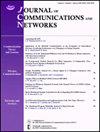迈向 5G 先进的非授权 NR 系统:物理层设计与性能
IF 3.2
3区 计算机科学
Q2 COMPUTER SCIENCE, INFORMATION SYSTEMS
引用次数: 0
摘要
在追求高可靠性和低延时的 5G 先进新无线电非授权(NR-U)系统的过程中,解决高错误率和高信令开销传输的挑战仍然是提高网络性能的关键。在这种情况下,为了降低错误率,可以采用重传等机制。然而,进行多次重传的代价是需要利用额外的传输资源,这反过来又会影响网络的频谱效率。这就进一步要求进行适当的调度,以减少数据传输过程中的资源浪费和不必要的碰撞。在本文中,我们将概述长期演进-许可辅助接入(LTE-LAA)技术的设计规范,以及在 7 GHz 以上频段实现 NR-U 操作的前瞻性改进。此外,我们还研究了选定设计功能的配置,以实现 NR-U 调度。具体来说,我们说明了在帧结构下选择切换模式、在混合自动重复请求(HARQ)程序下选择反馈值类型以及在无线链路控制(RLC)层下选择定时参数的好处和局限性。此外,我们还给出了仿真结果,以说明上述配置对 NR-U 性能的影响。本文章由计算机程序翻译,如有差异,请以英文原文为准。
Towards 5G-advanced NR-unlicensed systems: Physical layer design and performance
In the pursuit of a highly reliable and low-latency-enabled 5G-advanced new radio unlicensed (NR-U) system, addressing the challenge of high error rates and high signaling overhead transmissions remains key to improving network performance. In this context, to reduce error rates, mechanisms such as retransmissions can be employed. However, performing multiple retransmissions comes at the cost of utilizing extra transmission resources, which in turn affects the spectral efficiency of the network. This would further necessitate proper scheduling to alleviate resource wastage and undesirable collisions during data transmission. In this article, we provide an overview of the design specifications of the long-term evolution-license assisted access (LTE-LAA) technology and the prospective enhancements to enable NR-U operation in bands beyond 7 GHz. Additionally, we examine the configurations of selected design features to enable NR-U scheduling. Specifically, we illustrate the benefits and the limitations of the choice of the switching pattern under the frame structure, the feedback value type under the hybrid automatic repeat request (HARQ) procedure, and the timing parameters under the radio link control (RLC) layer. Besides, we present simulation results to depict the impact of the configurations mentioned above on the performance of NR-U.
求助全文
通过发布文献求助,成功后即可免费获取论文全文。
去求助
来源期刊
CiteScore
6.60
自引率
5.60%
发文量
66
审稿时长
14.4 months
期刊介绍:
The JOURNAL OF COMMUNICATIONS AND NETWORKS is published six times per year, and is committed to publishing high-quality papers that advance the state-of-the-art and practical applications of communications and information networks. Theoretical research contributions presenting new techniques, concepts, or analyses, applied contributions reporting on experiences and experiments, and tutorial expositions of permanent reference value are welcome. The subjects covered by this journal include all topics in communication theory and techniques, communication systems, and information networks. COMMUNICATION THEORY AND SYSTEMS WIRELESS COMMUNICATIONS NETWORKS AND SERVICES.

 求助内容:
求助内容: 应助结果提醒方式:
应助结果提醒方式:


